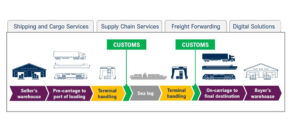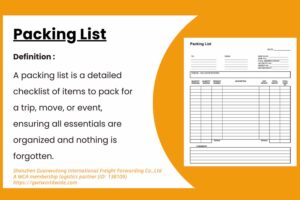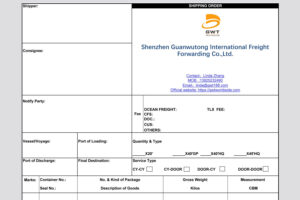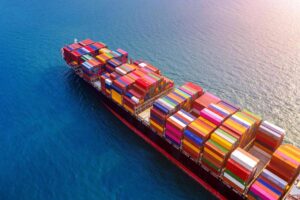Знания о процессе погрузки контейнеров: от сбора пустых контейнеров до погрузки контейнеров
Поймите процесс погрузки контейнера, чтобы лучше контролировать свой груз и грузоперевозки.
Узнайте о процессе морских перевозок премиум-класса от GWT Worldwide

Понимание процесса сбора контейнеров в Китае
Портовые операции в Китае
Процесс сбора контейнеров в Китае требует всестороннего понимания основных портов страны, каждый из которых является оживленным центром мировой торговли. Например, Шанхай - самый загруженный порт в мире, отличающийся передовыми технологиями и эффективностью работы. Знакомство с его планировкой и конкретными терминалами может значительно улучшить логистический опыт. Аналогичным образом, Шэньчжэнь служит важнейшими воротами для южного Китая, а такие терминалы, как Яньтянь и Шекоу, известны своими отлаженными процессами. Нинбо, стратегически расположенный в дельте реки Янцзы, предлагает глубоководные возможности, идеально подходящие для крупных судов, что делает его ключевым звеном в международных перевозках.
Навигация по портовой логистике и правилам
Понимание портовой логистики и правил очень важно. Таможенные процедуры в Китае требуют скрупулезного внимания к деталям: для оформления требуются такие ключевые документы, как коносамент и коммерческий счет-фактура. Привлечение таможенного брокера может облегчить этот процесс и обеспечить соблюдение правил импорта/экспорта. Кроме того, для составления бюджета очень важно знать о портовых сборах, включая плату за обработку грузов в терминале и плату за хранение. Большинство портов работают круглосуточно, но знание конкретных часов работы может помочь в планировании доставки грузов в непиковое время, что сократит время ожидания и повысит эффективность.
Предостережения для различных типов товаров
При работе с различными видами товаров необходимо соблюдать особые меры предосторожности. Например, скоропортящиеся товары требуют контейнеров с надежными холодильными установками. Контроль температурных режимов жизненно важен для сохранения качества продукции, а приоритетное внимание к быстрой очистке и транспортировке позволяет предотвратить порчу. Опасные материалы требуют строгого соблюдения правил безопасности, включая надлежащую упаковку и маркировку. Очень важно заранее получить необходимые разрешения, а также убедиться, что персонал хорошо обучен обращению с такими материалами. В отношении дорогостоящих товаров рекомендуется применять такие меры безопасности, как GPS-слежение и надежные пломбы. Оценка вариантов страхования для покрытия возможных убытков еще больше обезопасит эти ценные грузы.
Сотрудничество с местными партнерами
Сотрудничество с местными партнерами может значительно ускорить процесс сбора контейнеров. Выбор логистических провайдеров с сильным местным присутствием и опытом обеспечивает надежность и эффективность. Их знания местных правил и логистики могут оказаться бесценными, а налаживание четких каналов связи поможет оперативно решать любые вопросы. Не менее важно наладить отношения с портовыми властями. Регулярное взаимодействие и общение помогут вам быть в курсе изменений в процедурах, а участие в отраслевых мероприятиях поможет вам быть в курсе событий. Такие отношения могут способствовать более плавной работе и созданию более беспроблемного логистического опыта.
Понимая эти аспекты, компании могут более эффективно ориентироваться в сложностях китайских портов, повышая эффективность и сокращая возможные задержки. Такой комплексный подход обеспечивает более плавный процесс получения контейнеров, что в конечном итоге повышает эффективность управления всей цепочкой поставок.
Конечно! Вот продолжение статьи с расширенным содержанием под каждым заголовком:
Подготовка к приему контейнеров
Документация и соблюдение требований
Прежде чем приступить к процессу сбора контейнеров, необходимо убедиться, что вся необходимая документация в порядке. К ней относятся коносамент, коммерческий счет-фактура и упаковочный лист. Каждый документ должен точно отражать информацию о грузе, чтобы избежать задержек. Рекомендуется тесно сотрудничать с таможенным брокером, который сможет разобраться в сложностях китайских правил импорта/экспорта и обеспечить соблюдение местных законов. Этот шаг жизненно важен для беспрепятственного таможенного оформления и во избежание возможных штрафов или взысканий.
Планирование и координация
Эффективное планирование и координация являются ключом к эффективному сбору контейнеров. Это предполагает согласование прибытия судна с наличием транспортных ресурсов. Используйте цифровые системы отслеживания, чтобы следить за расписанием судов и предвидеть любые изменения. Координация с экспедиторами и местными транспортными компаниями гарантирует, что грузовики будут готовы к перевозке контейнеров сразу же после их оформления. Это позволяет сократить время ожидания и оптимизировать использование ресурсов, что ведет к более рациональной работе.
Процедуры на месте в порту
Досмотр и обработка контейнеров
По прибытии в порт контейнеры подвергаются осмотру для проверки их состояния и содержимого. Этот процесс включает в себя проверку на наличие повреждений, которые могли возникнуть во время транспортировки. Использование таких технологий, как RFID-метки, может способствовать эффективному отслеживанию и обработке. Сотрудники порта обучены бережному обращению с контейнерами, но важно, чтобы и ваша команда присутствовала при этом, чтобы контролировать процесс и следить за правильностью соблюдения всех протоколов.
Процесс погрузки и крепления контейнеров. Важный процесс погрузки контейнеров
Погрузка контейнера на транспортные средства требует точности и соблюдения стандартов безопасности. Правильное крепление контейнера необходимо для предотвращения его перемещения во время транспортировки, что может привести к повреждениям. Использование соответствующего крепежного оборудования, такого как замки-скобы и крепежные ремни, обеспечивает устойчивость контейнера. Обучение персонала безопасным методам погрузки имеет решающее значение для сохранения целостности груза и обеспечения соблюдения правил безопасности.
Логистика после сбора
Транспортировка и доставка
После того как контейнер получен, на первый план выходит эффективная транспортировка в конечный пункт назначения. Выбор правильного вида транспорта - автомобильного, железнодорожного или комбинированного - зависит от таких факторов, как расстояние, стоимость и срочность. Внедрение систем GPS-слежения позволяет контролировать груз в режиме реального времени, обеспечивая прозрачность и своевременное информирование клиентов. Убедитесь, что транспортные средства хорошо обслуживаются, а водители имеют большой опыт работы, что способствует бесперебойному процессу доставки.
Устранение задержек и проблем
Несмотря на тщательное планирование, могут возникнуть непредвиденные задержки. Наличие плана действий на случай непредвиденных обстоятельств необходимо для решения таких проблем, как пробки на дорогах, поломки оборудования или препятствия со стороны регулирующих органов. Установление надежных каналов связи со всеми заинтересованными сторонами позволяет быстро решать проблемы и сводит к минимуму сбои в работе. Гибкость и способность к адаптации являются ключевыми факторами для поддержания эффективности и соблюдения сроков поставки.
В статье представлены обширные знания о процессе погрузки контейнеров.
Возврат заполненного контейнера
Планирование возврата
Возврат полного контейнера требует тщательного планирования, чтобы согласовать его с портовыми операциями и избежать платы за простой. Необходимо согласовывать свои действия с судоходными линиями и портовыми властями, чтобы определить свободные временные интервалы для возврата контейнеров. Использование цифровых платформ для бронирования мест для возврата контейнеров может упростить этот процесс и обеспечить обновление информации о наличии свободных мест в режиме реального времени. Заблаговременное планирование и соблюдение графика возврата поможет избежать дополнительных сборов и обеспечит плавный переход.
Документация для возврата
Правильное оформление документов имеет решающее значение при возврате полного контейнера. Такие ключевые документы, как заказ на доставку и форма освобождения контейнера, должны быть заполнены точно. Эти документы подтверждают возврат контейнера и гарантируют, что он будет получен в хорошем состоянии. Сотрудничество с таможенными брокерами поможет убедиться в том, что все документы в порядке, и снизить риск задержек или несоответствий в процессе возврата.
Осмотр и оценка состояния
Перед возвратом контейнера необходимо провести тщательный осмотр, чтобы оценить его состояние. Это включает в себя проверку на наличие повреждений, которые могли возникнуть во время разгрузки или транспортировки. Документальное подтверждение состояния с помощью фотографий и отчетов может послужить доказательством в случае возникновения споров. Также важно убедиться, что контейнер чист и не содержит мусора, поскольку порты могут взимать плату за уборку, если контейнеры возвращены не в приемлемом состоянии.
Транспортная логистика
Организация перевозки для возврата заполненного контейнера требует тщательной координации. Выбор надежных транспортных компаний, имеющих опыт работы с возвратом контейнеров, крайне важен. Системы отслеживания в режиме реального времени позволяют контролировать ход обратного пути, обеспечивая своевременную доставку в указанный порт. Эффективное управление логистикой сводит к минимуму задержки и способствует беспрепятственному процессу возврата.
Решение неожиданных проблем
Несмотря на тщательное планирование, в процессе возврата контейнеров могут возникнуть непредвиденные проблемы. Это могут быть задержки на дорогах, неисправности оборудования или изменения в расписании порта. Наличие плана действий на случай непредвиденных обстоятельств и поддержание открытой связи со всеми заинтересованными сторонами поможет оперативно решить эти проблемы. Гибкость и активное решение проблем - это ключ к минимизации сбоев и обеспечению успешного возврата.
Процесс возврата заполненного контейнера так же важен, как и его первоначальный забор. Точное планирование, точная документация и тщательные проверки помогут предприятиям обеспечить бесперебойный процесс возврата. Эффективная транспортная логистика и способность справляться с непредвиденными трудностями еще больше повышают эффективность возврата контейнеров. Такой комплексный подход не только снижает затраты, но и укрепляет отношения с партнерами по перевозке и портовыми властями, способствуя созданию более надежной цепочки поставок.
Заключение
Успешная навигация по процессу сбора контейнеров в Китае требует глубокого понимания портовых операций, тщательной подготовки и эффективной координации. Уделяя особое внимание соблюдению требований, используя технологии и налаживая прочные партнерские отношения на местах, компании могут улучшить свои логистические операции и обеспечить своевременную и эффективную доставку грузов. Такой комплексный подход не только повышает эффективность цепочки поставок, но и укрепляет отношения с партнерами и клиентами, что в конечном итоге способствует успеху бизнеса.
































